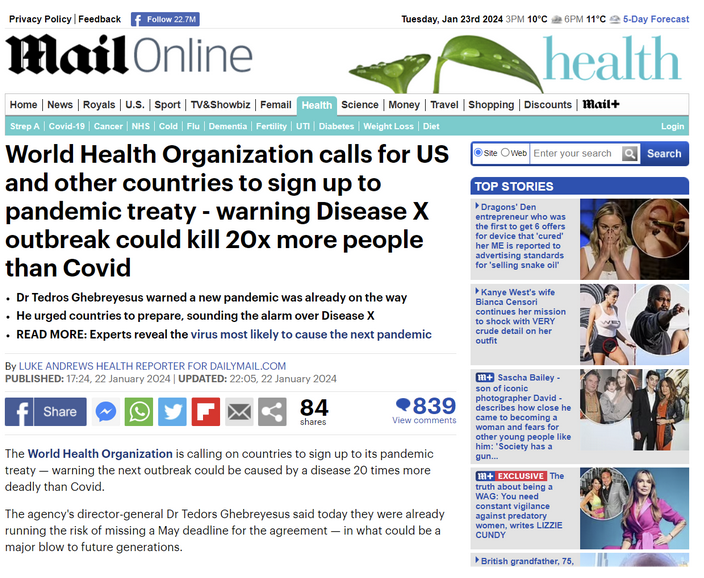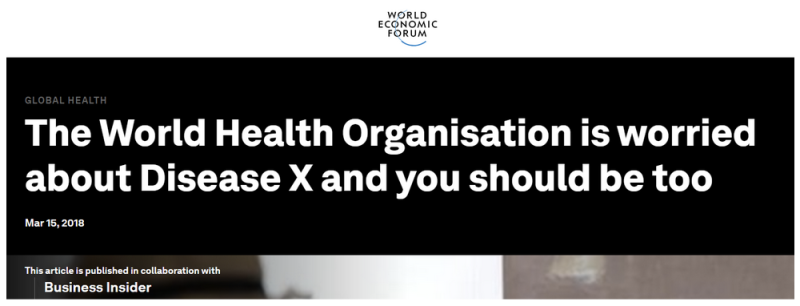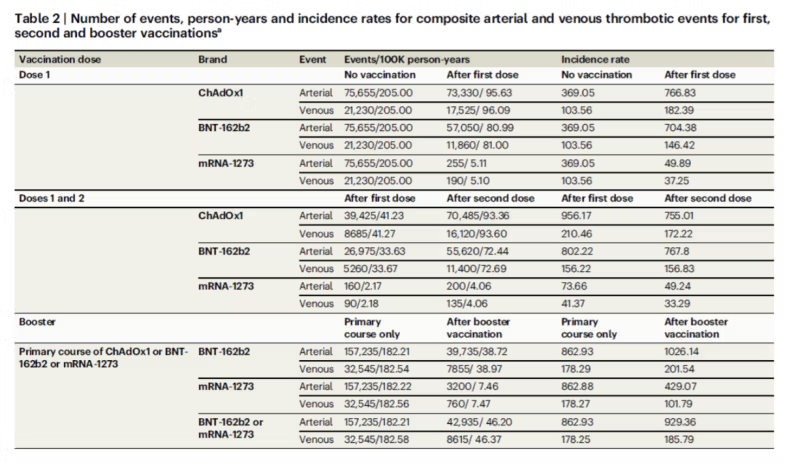Disease-X and Davos: This is Not the Way to Evaluate and Formulate Public Health Policy
Public health messaging should provide accurate information so that the public and their leadership can formulate appropriate responses, weighed against society’s competing priorities. Planning for the future requires scarce resources to be concentrated on areas of greatest need and with the expectation that they can achieve the widest benefit. However, policy can become skewed towards narrow vested interests when non-health goals, such as financial profit, come to compete with health benefits during the decision-making process. Thus, decision-making for health policy must be cognizant of, and resistant to, conflicts of interest and narratives that promote those interests.
To gain legitimacy, public health policy must be vested in institutions answerable to the public and based on reliable evidence. In the case of the recent World Economic Forum (WEF) venture in public health policy advocacy in Davos, neither of these measures of legitimacy were met. Also in question is legitimacy in the media coverage, where the basic tenets of journalism – questioning evidence, corroborating sources, providing context, and awareness of conflict of interest – seem to have gone missing.

On September 17th 2024, the WEF held a meeting on preparing for pandemic health threats, centered on a hypothetical pathogen, ‘Disease X.’ The term Disease X refers to an unknown infectious agent that could pose a serious threat to humanity. The WHO added Disease X to its list of prioritized pathogens in 2018 to stimulate better preparations for these types of hypothetical threats, particularly scenarios where vaccines and known therapeutics are unavailable.
The WEF is a private forum supported by, and representing, private corporate interests that control much of the world’s financial and economic activity. For this reason, it also attracts many senior politicians and public policy makers. While it could be argued that this is a reasonable forum for political leaders to court private sector input and financial commitments for already established public health policies, it is arguably an inappropriate forum for the making of public policy. Regardless, in the run up to Davos, Disease X was touted as being potentially 20 times more deadly than Covid-19. Using official WHO Covid-19 figures, this would equate to nearly 140 million deaths worldwide.
As expected, the debate around Disease-X and the WEF quickly became polarized. On one side, sceptics suggested that the WEF is merely a ‘globalist’ forum aimed to restrict state sovereignty and that Disease-X is designed to justify pandemic policies that reduce human liberties. On the other, there have been defenses of using Disease-X as a hypothetical scaffold for policy development as well as using the WEF forum as a place to help respond to this imminent ‘existential threat.’
Yet, the truth is likely somewhere in the middle. There are of course benefits to using hypotheticals in policy planning. Equally, there are of course vested geopolitical and ‘global’ corporate interests represented in Davos. Those interests include more than avoidance of the larger economic costs of the next pandemic, since there are also enticing business opportunities that such a hypothetical and somewhat open-ended narrative could present. It generates attention, response, and potential investment by private shareholders, but also governments, who have developed a considerable reliance on vaccines as the primary mechanism for pandemic preparedness and response.
Furthermore, intergovernmental agencies such as the WHO also understand the opportunities that Disease X generates. It helps to create a sense of urgency, enables a clear return on investment narrative, and legitimates the agency’s place as the epistemic authority for health policy post-Covid. To put it bluntly, creating a sense of urgency and future crises will diminish reflection, allowing policies to more quickly manufacture agreement and mobilize resources.
It is here where interests align at the WEF. And it is here where that alignment can skew and pollute health policy in ways not in the wider interests of global public health. One way to determine how appropriately these interests align with public health, and whether they should help determine its future, is to unpack and better understand the assumptions that are driving the WEF pandemic response narrative. In this case, Disease X.
How Big is the Pandemic Threat?

WEF laid out the reasoning behind convening this week’s pandemic panel in a 2018 article on its website, which was updated for the 2024 meeting. The article states:
The inescapable truth for those who study disease outbreaks, new viruses, and the spread of illness is a haunting one.
The next pandemic is coming.
Known, incurable diseases lurk in hidden reservoirs all over the world. Thousands of unknown viruses circulate around the globe.
Much of this statement is technically correct. Though few who study outbreaks may be as “haunted” by these fears as the WEF suggests, since natural outbreaks of major impact are uncommon and less harmful than many endemic infectious diseases (see below). In addition, it is inescapably true that thousands of viruses do exist and remain undiscovered, since nature’s diversity is vast. Yet, nearly all are harmless to humans, as we have been encountering them or their variants for hundreds of thousands of years. Occasionally, in these everyday encounters, a more significant outbreak will occur. What then matters is its frequency and severity.
The potential exception, as the WEF went on to point out, is non-natural introduction of a pathogen through laboratory manipulation of viruses. However, as a biosecurity issue, this would normally fall under approaches and policies of national and international security interest and would not be best handled by private for-profit entities or rival geopolitical national laboratories that may have had a hand in creating them. This is therefore a strange subject for a private Swiss corporate club. So, we must assume, for sake of argument, that Disease X is considered to be of natural origin within the WEF’s narrative.
In terms of natural pathogenic threats, the WEF listed a priority disease list developed by the WHO in 2018, which outlines what it understood to be the potential major threats to human health (Public Health Emergencies of International Concern). Of note, it does not include influenza, as extensive surveillance and response mechanisms already exist for influenza outbreaks:
- Covid-19
- Crimean-Congo hemorrhagic fever
- Ebola virus disease and Marburg virus disease
- Lassa fever
- Middle East respiratory syndrome coronavirus (MERS-CoV) and Severe Acute Respiratory Syndrome (SARS)
- Nipah and henipaviral diseases
- Rift Valley fever
- Zika
- “Disease X”
Beyond Covid-19, the only disease in this list to have more than 10,000 recorded deaths is Ebola. The West African Ebola outbreak of 2014-15 – by far the largest in history – had a mortality of 11,325. Except for Lassa fever, an endemic West African disease, no other disease in the list appears to have over 1,000 identifiable deaths reported globally. SARS and MERS-CoV caused about 800 each.
This is where context is important for understanding public health risk and to give the current WEF policy narrative some perspective. Tuberculosis causes 1.3 million deaths per year, or over 3,500 deaths per day, while malaria kills over 600,000 children every year. Cancer and heart disease kill, globally, many times more people (10 million and 17.9 million). As a result, such ailments cause these outbreak diseases to pale in comparison, but excite less fear as we have become accustomed to such numbers, even when, in cases such as malaria, they are readily preventable.
From a public health perspective this is what should excite most interest and until recently received most funding. Relatedly, the major causes of the extension of average lifespan in more developed countries – improved sanitation, nutrition, general living conditions, and antibiotics – were a key focus of improving health (and consequently economies in lower income settings).
Unfortunately, this recent shift to concentrate on unusual and low-impact diseases could have significant costs. For example, recent pandemic preparedness and response policy narratives are insisting that countries with higher preventable health burdens, such as malaria, accept diversion of resources to address unknown pandemic risks. According to the G20 report A Global Deal for a Pandemic Age, an estimated $26.4 billion a year in pandemic risk investments will be required from low- and middle-income countries to fill existing preparedness gaps, with an additional $10.5 billion from Overseas Development Assistance.
In the context of recognized outbreaks, Covid-19 is an outlier – and represents by far the most significant pandemic in 50 years in terms of deaths reported by the WHO (the 2009 pandemic influenza outbreak killed less than seasonal influenza normally does). In other words, the WHO priority watchlist has a very low disease burden in relation to the world’s biggest and most chronic killers.
That is, of course, until Disease X strikes.
Disease X: Manufacturing Severity
In the build-up to WEF 2024 and its pandemics panel, the WEF website posed the following question: “with fresh warnings from the World Health Organization that an unknown ‘Disease X’ could result in 20 times more fatalities than the coronavirus pandemic, what novel efforts are needed to prepare healthcare systems for the multiple challenges ahead?” This alert was immediately picked up and repeated by many news outlets, which in turn sparked several controversies on social media and via public statements made by politicians and public health professionals.
However, in terms of evidence, it remains unclear whether the WHO actually claimed that Disease X should ever be understood as being this severe. In fact, in our search, it was not possible to find where the WHO had made this direct numerical attribution. More interestingly, the claim that Disease X could be 20 times more deadly than Covid-19 has now been removed from the WEF website, suggesting that this error has now been recognized.
By doing a basic search, the origin of this “20 times” calculation seemingly comes from a website article published by the Birmingham Mail on 24 September 2023. The Birmingham Mail article states that “the new disease could be 20 times more deadly than coronavirus, which caused 2.5 million deaths” (it should be noted that this is not accurate, and it is not clear why the article used this figure – the official figure for Covid-19 was around 7 million on that date). This claim of ‘20 times’ is apparently derived from a statement made by Kate Bingham, the former chair of the UK’s Vaccine Taskforce, who told the Daily Mail in an earlier article that “the 1918–19 flu pandemic killed at least 50 million people worldwide, twice as many as were killed in World War I. Today, we could expect a similar death toll from one of the many viruses that already exists.”
Consequently, it appears that the author of the Birmingham Mail article arrived at the calculus of “20 times more deadly” by taking 50 million Spanish flu deaths and dividing it by 2.5 Covid-19 deaths to relate the magnitude of severity for Disease X. For WEF, this multiplier was seemingly picked up for use on its website, but this time referring to much higher Covid-19 mortality based on actual WHO reported Covid deaths (e.g. 7 million).
By this faulty logic, Disease X would hypothetically amount to 7 million Covid deaths x 20 = 140 million deaths. This would put Disease X in truly uncharted territory, far beyond any historical pandemic precedent. And it is extraordinary that no one, including noted health professionals, balked at this eye-watering number. What is also extraordinary is that major news outlets like the Daily Mail continue to parrot these under-substantiated claims post-Davos, which reproduces narratives in such a way that they become a social fact influencing practice, despite having weak scientific foundations.
This is troubling for several reasons, but mainly in terms of evidence-based policy and the pollution that can occur when forums like the WEF overstep their remit. Although the use of hypotheticals such as Disease X can be extremely useful for stress testing preparedness and for wider policy reflections, they should not be devoid of known experience. In addition, as in the case of its inclusion on the WHO’s watchlist, hypothetical diseases like Disease X can act as a general placemark for unknown diseases that should also be taken into consideration in our preparedness efforts. But again, this unknown should still be based on ‘known unknowns,’ to borrow a cliché.
Therefore, any hypothetical like Disease X and associated modelling should be based on empirical conditions rather than mere speculation. Otherwise, we could simply pick any calamitous number from thin air and multiply it by official Covid-19 or Spanish flu deaths. With regards to the latter, this might be an equally problematic model when recontextualized, since the likelihood of the Spanish flu resulting in the same number of deaths in 2024 is greatly reduced. Most Spanish flu deaths are attributed to a lack of antibiotics (This was over a century ago, we have antibiotics now!). Medical care has, we hope, also improved in the past 100 years. Against this backdrop, such comparisons are somewhat fanciful.
Lastly, evidence-based policy is predicated on the idea that policy decisions should be substantiated by rigorously established objective evidence and not based merely on ideology or common belief. This standard raises several concerns regarding how Disease X is currently being used and the basis upon which its severity has been wrongly purported by WEF and many others. In other words, the underwriting evidence base for public health discussions, such as those that took place at Davos, should not be based on a Birmingham Mail article that paraphrases an estimated calculus from an unsubstantiated comment made during an interview using incorrect mortality statistics. This cannot withstand even modest scrutiny and makes the whole Davos affair an embarrassment to rational thought.
Public Health and Pharma Profit Are Not the Same
Planning for outbreaks is a logical priority in public health. Allocating resources in the context of competing priorities and understanding the health costs of resource diversion from higher burden diseases is fundamental to such policy development. What is the antithesis of good public health is the promotion of fear, exaggeration, and random hypothetical calculi that have reverberated unreflectively across numerous communication and policy channels for months.
In the context of interest promotion, it makes sense that pharmaceutical corporations, their investors, immediate benefactors, and even the media produce such material. It is an issue from which they stand to gain profit and influence. Yet, this should not be mistaken for a legitimate approach to health policy or population health, and it should be rejected outright as a credible approach to the development of public health policy.

No comments:
Post a Comment